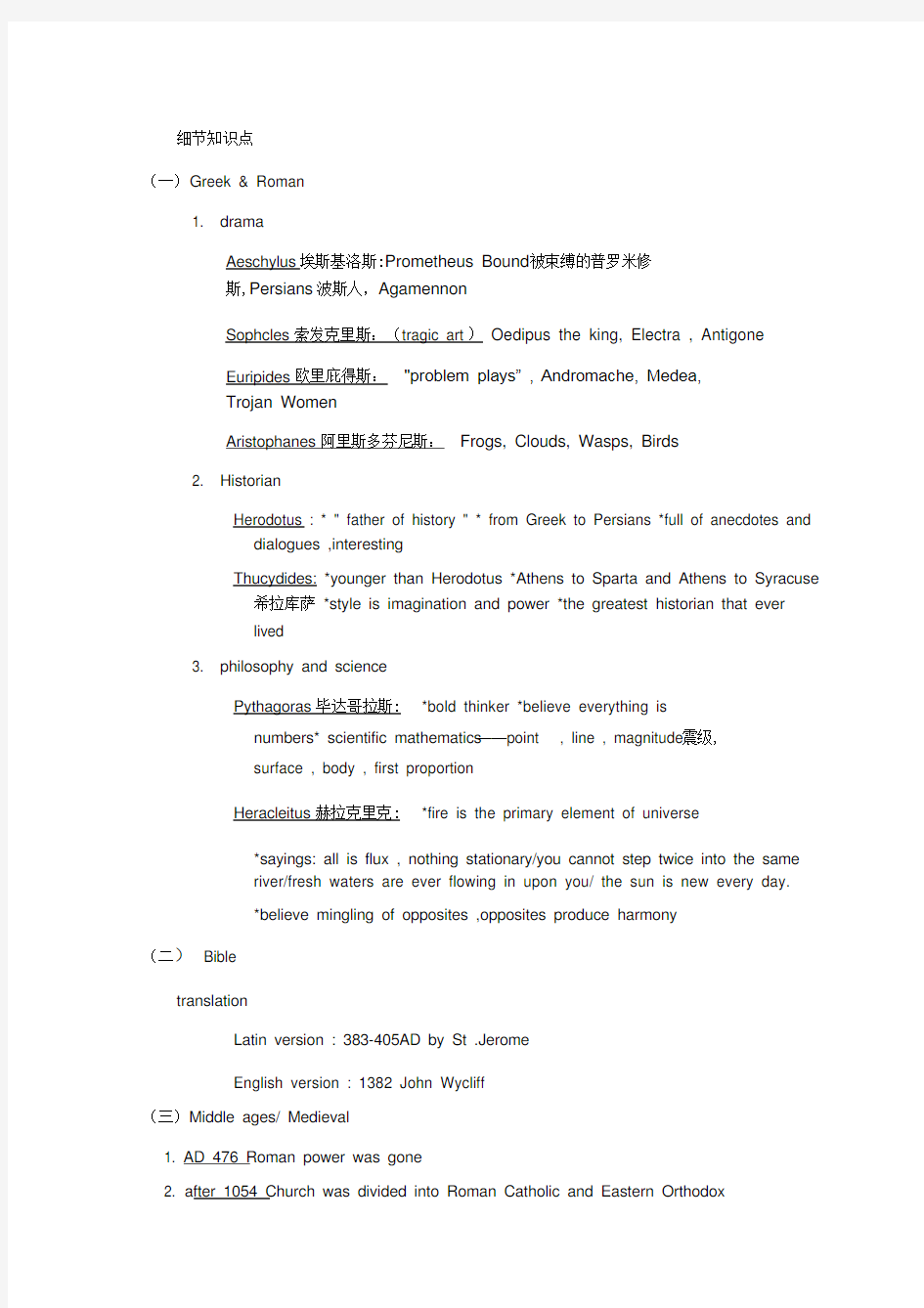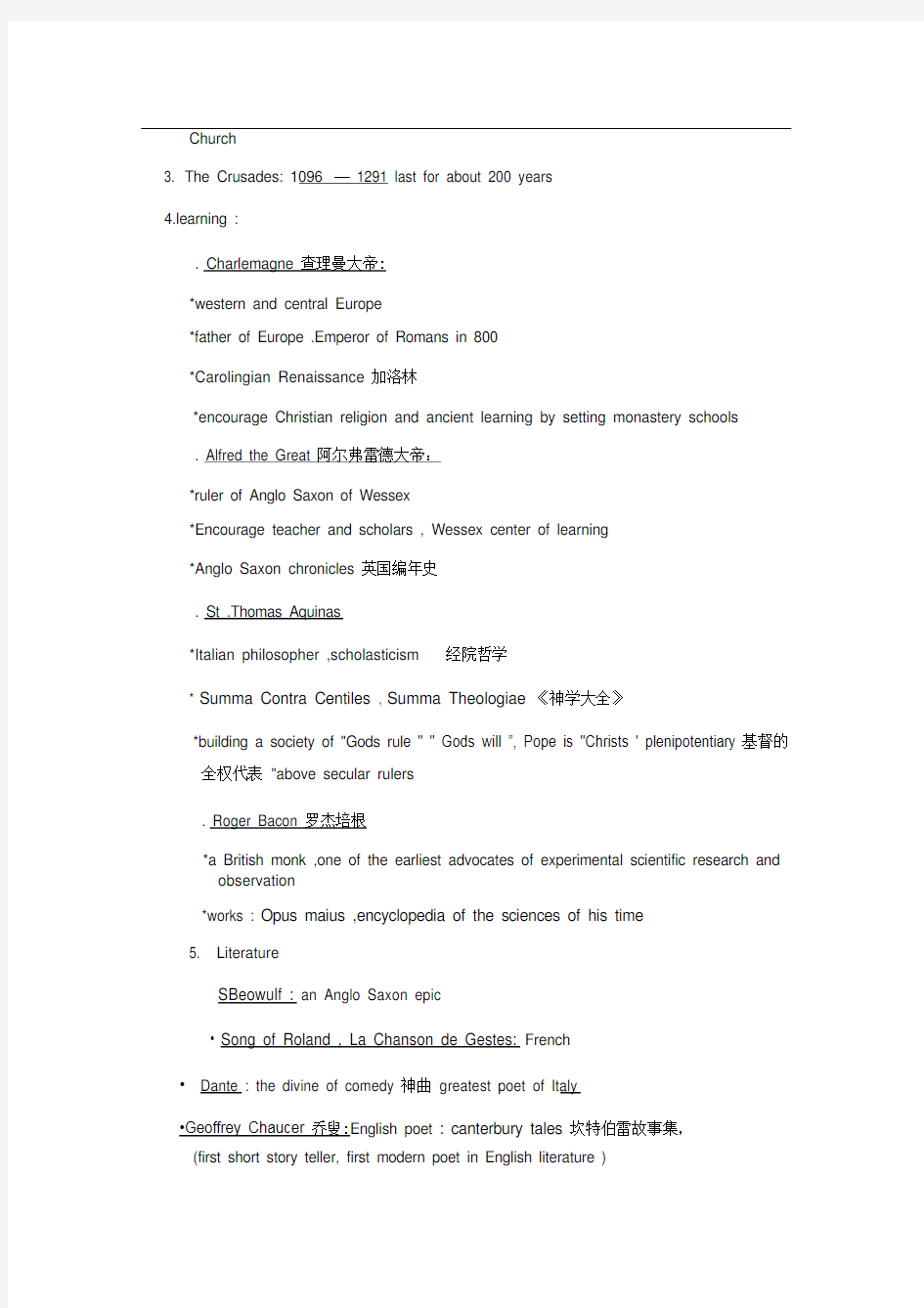

细节知识点
(一)G reek & Roman
1. drama
Aeschylus埃斯基洛斯:Prometheus Bound被束缚的普罗米修
斯,Persians波斯人,Agamennon
Sophcles 索发克里斯:(tragic art ) Oedipus the king, Electra , Antigone
Euripides 欧里庇得斯:"problem plays” , Andromache, Medea,
Trojan Women
Aristophanes 阿里斯多芬尼斯:Frogs, Clouds, Wasps, Birds
2. Historian
Herodotus : * " father of history " * from Greek to Persians *full of anecdotes and dialogues ,interesting
Thucydides: *younger than Herodotus *Athens to Sparta and Athens to Syracuse 希拉库萨*style is imagination and power *the greatest historian that ever
lived
3. philosophy and science
Pythagoras 毕达哥拉斯: *bold thinker *believe everything is
numbers* scientific mathematics——point , line , magnitude 震级,
surface , body , first proportion
Heracleitus 赫拉克里克: *fire is the primary element of universe
*sayings: all is flux , nothing stationary/you cannot step twice into the same
river/fresh waters are ever flowing in upon you/ the sun is new every day.
*believe mingling of opposites ,opposites produce harmony
(二)Bible
translation
Latin version : 383-405AD by St .Jerome
English version : 1382 John Wycliff
(三)Middle ages/ Medieval
1. AD 476 Roman power was gone
2. after 1054 Church was divided into Roman Catholic and Eastern Orthodox
Church
3. The Crusades: 1096 — 1291 last for about 200 years
4.learning :
. Charlemagne 查理曼大帝:
*western and central Europe
*father of Europe .Emperor of Romans in 800
*Carolingian Renaissance 加洛林
*encourage Christian religion and ancient learning by setting monastery schools
. Alfred the Great 阿尔弗雷德大帝:
*ruler of Anglo Saxon of Wessex
*Encourage teacher and scholars , Wessex center of learning
*Anglo Saxon chronicles 英国编年史
. St .Thomas Aquinas
*Italian philosopher ,scholasticism 经院哲学
* Summa Contra Centiles , Summa Theologiae 《神学大全》
*building a society of "Gods rul e " " Gods will ”, Pope is "Christs ' plenipotentiary 基督的全权代表"above secular rulers
. Roger Bacon 罗杰培根
*a British monk ,one of the earliest advocates of experimental scientific research and observation
*works : Opus maius ,encyclopedia of the sciences of his time
5. Literature
SBeowulf : an Anglo Saxon epic
? Song of Roland , La Chanson de Gestes: French
?Dante : the divine of comedy 神曲greatest poet of Italy
?Geoffrey Chaucer 乔叟:English poet : canterbury tales 坎特伯雷故事集,
(first short story teller, first modern poet in English literature )
(四)Renaissance
1. started in Florence and Venice , Italy
2. heart of Renaissance philosophy is greatness of man , humanism
3. masterpieces :
?Giovanni Boccaccio 薄伽丘:D ecameron十日谈(the greatest achievement of prose fiction 散文小说in the middle ages )
. Francesco Petrarch 彼德拉克:
*discover Cicero s Oration Oro Arochia ,a Roman defense of poetry
*Works : Canzoniers (lyrical) , Africa, Metrical Epistles, On Contempt for the Worldly Life , On Solitude, Ecologues, The Letters
SGiotto 乔托:
*forerunner of Renaissance , led the way to humanism , realistic
depiction of space
*works: Flight into Egypt ,Betrayal of Juda s
?Giorgione 乔尔乔捏:Tempesta , Sleeping Venus
(use of colour schemes to unify picture and most revolutionary
result in this sphere)
?Leonardo da Vinci:
*painter, sculptor, architect, musician, mathematician, engineer, inventor, anatomist, geologist, cartographer, botanist, and writer.
*12 paintings 5000 books ,Renaissance man in the true sense of word.
* Last Supper(most famous religious pictures) , Mona Lisa(most portrait)
? Michelangelo Buonarroti:
?an Italian sculptor, painter, architect, poet, and engineer
?David , Sistine Chapel , Dying Slave ,Moses
?Raphael: Madonna (Virgin Mary)各种圣母画,school of Athens
?Rabelais 拉伯雷:French , Gargantua and Pantagruel 《巨人传》
?Pleiade 七星诗社:French ,leader is Pirre de Ronsard( Sonnet Pour
Helene),发扬保卫法兰西语言
?Cervantes 塞万提斯:Spanish , Don Quixote 1062
?Erasmus : Dutch , Renaissance humanist, Catholic priest, teacher, and
theologian , Greek edition of New Testament , Praise of Folly《愚人颂》?Durer : German ,follower of Martin Luther
the four horsemen of apocalypse 夭启四骑士
knight , death and the devil
?Thomas more :英国人、Utopia 乌托邦,conclusion
?Shakespeare :英国人Twelfth night , As you like it , Hamlet, Othello ,
King Lear , Macbeth, Antony and Cleopatra ,
Sonnets, King Henry 5 , 6
二.名词解释
1. Renaissance
Renaissance is a period of western civilization between 14-17th century.
The word Renaissance means revival .it also means the revival of interest in
ancient Greek and Roman culture , which started in Florence and Venice , Italy .
the heart of~is humanism.
2 . Reformation
?was a 16th century religious movement as well as a socio-political
movement ,which began with Martin Luther 's 95 theses in 1517. The
Reformation began as an attempt to reform the Roman Catholic Church.
3 . Middle ages
~is also called Medieval , "the year of faith "* or the thousand-year period
following the fall of the western roman empire in the 5 th century .it came between ancient times and modern times .During this period Germanic kingdom grew into nations such as England ,French ,Spain, Italy, Germany.
4 . Feudalism
~is a system of holding land in exchange for military service .the word
~was derived from the Latin "feudum " , a grant of land.
5 Catholic
~Means " universal ". ~church was a highly centralized and disciplined international
religious organization .in the middle ages ,almost every Europeans belonged to it.
6. old testament
~is one of the two parts of the Bible ,which is about the God and the laws of God.
Testament means agreement — the agreement between God and man.
7. Pentateuch 摩西五书
The oldest first five parts of the Bible including Genesis ,Exodus , Leviticus,
Numbers , Deuteronomy
8. doric :
one of Greek architecture styles , ~is also called masculine style .it 's sturdy 坚定的,powerful , severelooking , showing sense of proportions and numbers.
Ionic :
feminine style graceful and elegant , showing wealth of ornament 装饰
三.问答
1. What happened in Western Europe after the decline of the Roman Empire?
After the Roman Empire lost its predominance 优势,a great many Germanic Kingdoms began to grow into the nations know as England, France, Italy, and
Germany in its place. These nations of Western Europe were in the scene of frequent wars and invasions. The political unity had given way to widespread destruction and confusion. Hunger and disease killed many lives and village fell into ruin and great areas of land lay waste. There was no central government to keep the order. The only organization that seemed to unite Europe was the Christian church. Christianity was almost the all and the one of Medieval lives in western Europe and took lead in politics, law, art, and learning for hundreds years.
2. What were the cultural characteristics of the period from 500 to 1000?
Above all, the cultural characters of this period were the heritage and achievement of Roman culture and the emergence of Hebrew and Gothic culture.
3. What made Italy the birthplace of the Renaissance?
Because of its geographical position, _ foreign trade developed early in Italy. This brought Italy into contact with other cultures and gave rise to urban economy and helped Italy accumulate wealth which was an essential factor for the flowering of art and literature.
For two centuries beginning from the late 15th century, Florence was the golden city which gave birth to a whole generation of poets, scholars, artists and sculptors._ There was in
Florence a revival of interest in classical learning and rising of humanist ideas.
And to spread the new ideas, libraries and academies were founded.
In the 15th century printing was invented and helped to spread humanist ideas.
4. How did Italian Renaissance art and architecture break away from medi eval traditions? The Italian Renaissance art and architecture radically broke away from the medieval methods of representing the visible world. Compared with the latter, the former has t he following distinct features:
(1) Art broke away from the domination of church and artist who used to be craftsm en
commissioned by the church became a separate strata doing noble and creati ve work
(2) Themes of painting and architecture changed from purely celestial realm focusing on the
stories of the Bible, of God and Mary to an appreciation of all aspects of n ature and man;
(3) The artists studied the ruins of Roman and Greek temples and put many of the pr inciples
of ancient civilization into their works;
⑷ Artists introduced in their works scientific theories of anatomy and perspective.